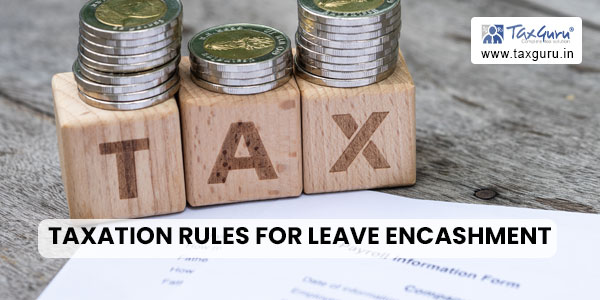Explore the taxation rules for leave encashment, covering taxability during service, retirement, and for legal heirs. Stay updated with the latest CBDT relief, raising the exemption limit to ₹25 lakh for non-government salaried employees, effective April 1, 2023. Learn about the conditions under Section 10 of the Income Tax Act and stay informed about the tax benefits available to employees for leave encashment.
Leave encashment is a process in which employees receive monetary compensation for their unused or accumulated leave days. It is a common practice in many organizations where employees are entitled to a certain number of paid leave days per year. These leaves can be utilized for various purposes, such as vacation, personal or family emergencies, or illness.

Leave encashment is offered as a benefit to employees, providing them with financial compensation for the leave days they haven’t utilized. This can be particularly advantageous for employees who are unable to take their leaves due to work commitments or personal circumstances.
By opting for leave encashment, employees can convert their unused leaves into additional income, thereby receiving compensation for their accumulated unutilized leave balance.
Different types of leaves typically available to employees:
- Casual Leave
- Earned Leave Or Privilege Leave
- Medical Leave
- Holiday Leave
- Maternity Leave etc.
Taxation of Leave Encashment (before amendment):
|
Sl. |
Particulars of Leave Encashment | Taxability |
| 1 | Received During Service | The entire amount is considered taxable and forms part of their ‘Income from Salary.’
*please note that tax benefits can be claimed. (section 89 and Form 10E under IT Act 1961) |
| 2 | Received at the time of retirement or resignation: | For Govt. Employees: fully tax-exempt.
For non-government employees: The taxability depends on the provisions of Section 10(10AA) of the Income Tax Act as per which the least of the following is exempt: a. Actual leave encashment received. b. 10 months’ average salary. c. Cash equivalent of unutilized earned leave, subject to a maximum of 30 days per year of service. |
| 3 | Legal Heir of a Deceased Employee: | For government and non-government employees: The entire amount is fully tax-exempt. |
Latest Update by CBDT:
The Central Board of Direct Taxes (CBDT) has raised the tax exemption limit on leave encashment for non-government salaried employees to ₹25 lakh. This relief applies to the period of earned leave in the employee’s credit at the time of retirement, whether on superannuation or otherwise. The new limit is effective from April 1, 2023.
Under the Income Tax Act, the total tax-exempt amount for leave encashment of salaried private sector employees shall not exceed ₹25 lakh. Government employees, on the other hand, enjoy full tax exemption for the leave encashment amount received. The tax benefits for private sector employees are subject to the conditions listed under Section 10 of the Income Tax Act, which deals with incomes exempt from taxation.
****
Disclaimer: Every effort has been made to avoid errors or omissions in this material. In spite of this, errors may creep in. Any mistake, error or discrepancy noted may be brought to our notice which shall be taken care of in the next edition. In no event the author shall be liable for any direct, indirect, special or incidental damage resulting from or arising out of or in connection with the use of this information.






Sir I retired from banking service on 31 Jan 2023. Shall i claim for leave encashment on retirement of Rs 25 lakh